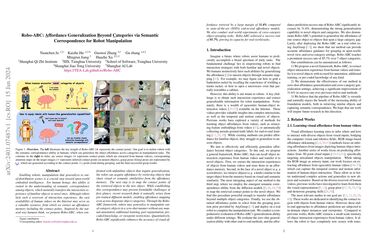Robo-ABC: Affordance Generalization Beyond Categories via Semantic Correspondence for Robot Manipulation
Enabling robotic manipulation that generalizes to out-of-distribution scenes is a crucial step toward open-world embodied intelligence. For human beings, this ability is rooted in the understanding of semantic correspondence among objects, which naturally transfers the interaction experience of familiar objects to novel ones. Although robots lack such a reservoir of interaction experience, the vast availability of human videos on the Internet may serve as a valuable resource, from which we extract an affordance memory including the contact points. Inspired by the natural way humans think, we propose Robo-ABC: when confronted with unfamiliar objects that require generalization, the robot can acquire affordance by retrieving objects that share visual or semantic similarities from the affordance memory. The next step is to map the contact points of the retrieved objects to the new object. While establishing this correspondence may present formidable challenges at first glance, recent research finds it naturally arises from pre-trained diffusion models, enabling affordance mapping even across disparate object categories. Through the Robo-ABC framework, robots may generalize to manipulate out-of-category objects in a zero-shot manner without any manual annotation, additional training, part segmentation, pre-coded knowledge, or viewpoint restrictions. Quantitatively, Robo-ABC significantly enhances the accuracy of visual affordance retrieval by a large margin of 31.6% compared to state-of-the-art (SOTA) end-to-end affordance models. We also conduct real-world experiments of cross-category object-grasping tasks. Robo-ABC achieved a success rate of 85.7%, proving its capacity for real-world tasks.
PDF Abstract
